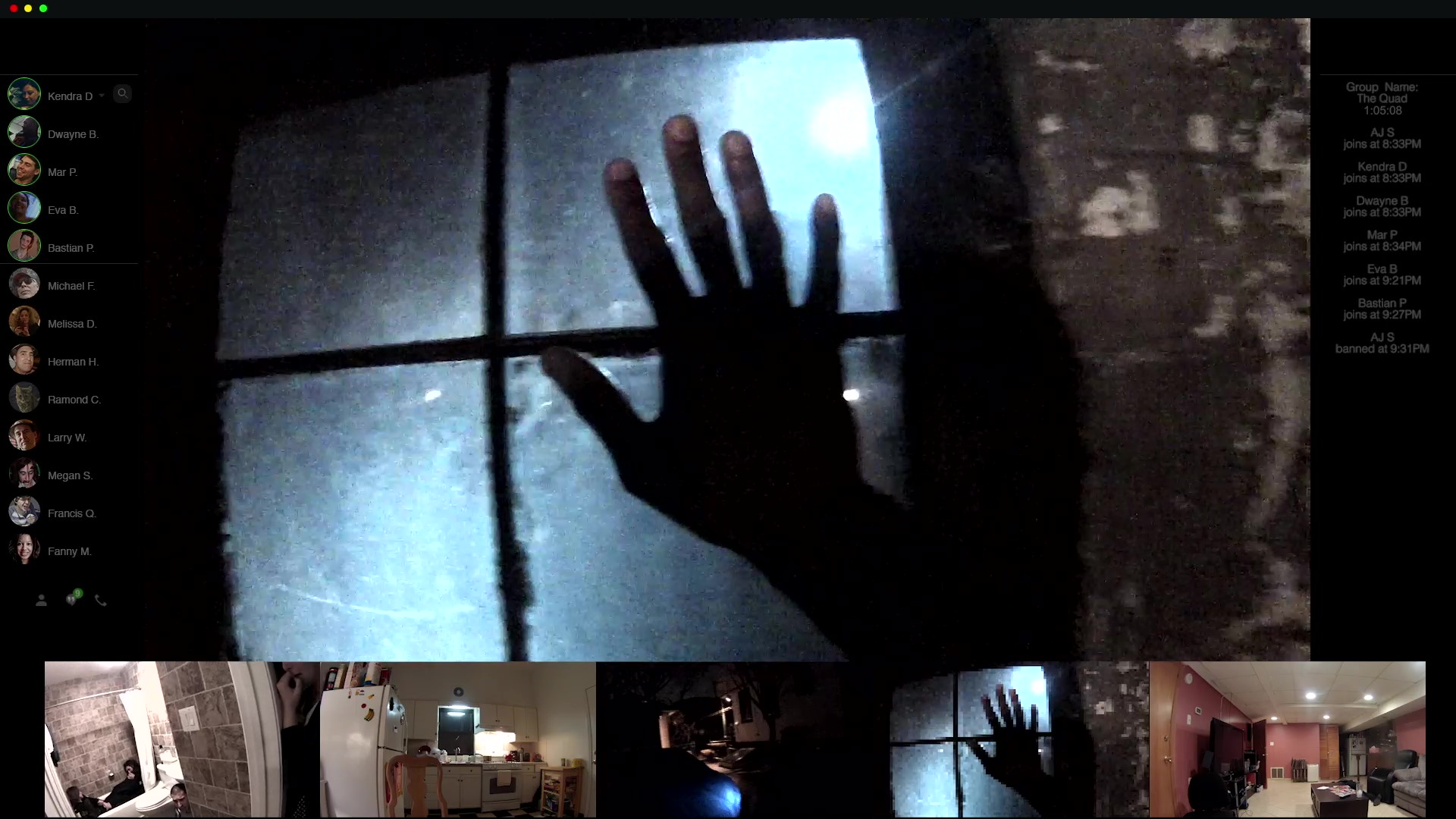Movies
[Review] A Weak Mythology and No Rules Hinder ‘E-Demon’

There have been a number of attempts the “single screen” thriller in recent years: Nacho Vigalondo’s Open Windows, Unfriended and its 2018 sequel Unfriended: Dark Web, and, most recently, Searching. While each film has had varying degrees of success in using the single screen technique – by which I mean everything plays out in various windows on one computer screen – there’s something thrilling and experimental about watching filmmakers attempting to adapt a different kind of visual language for the cinematic form. Into this subgenre now joins E-Demon, the debut feature from writer/director Jeremy Wechter.
A group of college friends (Julia Kelly, John Anthony Wylliams, Christopher Daftsios, and Ryan Redebaugh) have remained in touch over the years through regular online group chats. One night, though, their chat is invaded by a demon that has escaped its prison and gone viral, possessing people virtually and making them do unspeakable things, resulting in the famous case the movie identifies as “The Quad Murders.”
Watching E-Demon, I was struck by the thought that it’s a better adaptation of Stephen King’s Cell than the actual movie adaption of Stephen King’s Cell. That’s because what’s best about E-Demon is the way that it uses the prevalence of technology to show how easy it would be for something to spread if, in fact, technology were to become the primary means of delivery for a virus. We’re looking at screens all day, carrying them arounds in our pockets and purses, checking in on them every chance we get. Hell, you’re reading this review on a screen right now. As the film goes on and the possession infection continues to grow, there’s something haunting about how Jeremy Wechter portrays the spread: you tell five friends, those five friends each tell five friends, those five each friends tell five, and so on and so on. The technology isn’t presented as inherently evil in E-Demon, but it is an insidious gateway through which evil can slip pretty easily.
I have to give E-Demon a lot of credit for technical ambition, too. The advantage of shooting horror films in the found footage style is that the filmmaker can totally limit the audience’s point of view, never showing more than exactly what they want seen. Because of how it’s told across four different Skype windows, E-Demon doesn’t exactly have that advantage. Sure, Wechter manipulates what he does and does not want us to see by virtue of what is most prominent on the screen, but he’s always making use of the smaller windows at the bottom of the frame, too. Sometimes what we don’t see down there is more effective than what we do. The way he orchestrates all of the visual information is impressive, a kind of juggling act that really does reflect the way we consume information in the modern era. Sometimes that means opening up a chat window where a side conversation is at odds with what’s happening on screen, increasing the level of paranoia and making all of the characters unsure of who to trust. (Oh, I forgot to mention that for the first half of the movie, the four leads are constantly playing pranks on one another called “freakouts,” established as something they’ve always done. It’s repetitive and a little annoying and just a tool to keep us off balance of what is real and what is fake.)
The rest of E-Demon doesn’t work as well for me. Unlike the other single screen films produced to this point, all of which use the format to explore various aspects of modern technology (be it the ways we use it to communicate and/or bully each other anonymously, the way information has been made available, the ways it can be used against us), the relationship this story has to technology is very thin beyond “it’s everywhere.” That makes the single screen little more than a hook. It’s the next step in the evolution of the found footage film – a way for filmmakers to turn the limitations of their budgets into storytelling assets. I admire that sort of ingenuity, but many of the pitfalls are the same. Wechter uses the same frustrating device of distorting the frame or creating artificial glitches when it’s convenient for a scare, and the technique grows tiresome in its predictability. There are also a lot of questions raised about the logic of how the tech actually works, whether it’s character switching back and forth from laptops to headsets or going anywhere they want without ever losing WiFi. These are nitpicks and not what I ever want to be noticing when watching a movie, but the fact that I was pulled out repeatedly suggests that maybe it wasn’t working for me the way I hoped.
The movie is also hindered somewhat by never explaining its own rules. Even outside of its totally unnecessary framing device, E-Demon introduces and creates its own mythology, but never goes much further than “it’s a demon.” It could be any evil force, really, and the way the possessions work change from scene to scene. Characters appear and disappear in a way that’s more confusing than anything else, and entire subplots feel dropped almost as quickly as they’re introduced. The performances, while all well-intentioned, are effective at best and wildly inconsistent at worst, once again pulling me out of the film during moments I’m meant to feel total terror.
I don’t know that any movie has cracked the “single screen” technique just yet, but I find myself fascinated by each new attempt for the way in which it manipulates cinematic language. I admire a lot of what E-Demon wants to do, but only found it successful in fits and starts beyond its primary conceit. There are some ideas the movie presents that are still rattling around in my head hours later, but it’s less effective in the moment. I don’t think it succeeds overall, but I also don’t think it can be quickly dismissed.
E-Demon released on VOD September 14th.

Movies
Rated “R” ‘The Little Mermaid’ Horror Movie Coming Soon; Watch the Trailer

Following in the wake of Winnie the Pooh and Mickey Mouse getting their own horror movies, Hans Christian Andersen’s The Little Mermaid is the next to get the twisted treatment.
Originally published in 1837, the original tale of The Little Mermaid is now in the public domain, and MSR Media International presents their own horror version of the tale this year.
The Little Mermaid is being distributed by Grindstone Entertainment Group, and the film has officially been rated “R” this week for “Language, some violence and brief nudity.”
In the film from director Leigh Scott, “Dr. Eric Prince, an archaeologist, makes a dramatic discovery on a small Caribbean island—proof of an ancient, advanced prehistoric society. While his dig is in progress, he meets the mysterious and beautiful Aurora Bey and falls in love. Her arrival coincides with several mermaid sightings and strange disappearances.
“When Eric’s friend and mentor, Dr. Ashley, arrives on the island, Ashley uncovers the true identity of Aurora and the dangers of the hidden evil inside Eric’s dig site. Will Eric heed his friend’s advice, or will he be blinded by love and the power of the siren, allowing the world to fall to the forces of evil?”
Lydia Helen, Mike Markoff and Jeff Denton star in The Little Mermaid.
You can watch the trailer now over on MSR Media International’s website.














You must be logged in to post a comment.